Journal of the American Medical Directors Association
VerifiedAdded on 2022/08/27
|12
|3273
|32
AI Summary
Contribute Materials
Your contribution can guide someone’s learning journey. Share your
documents today.
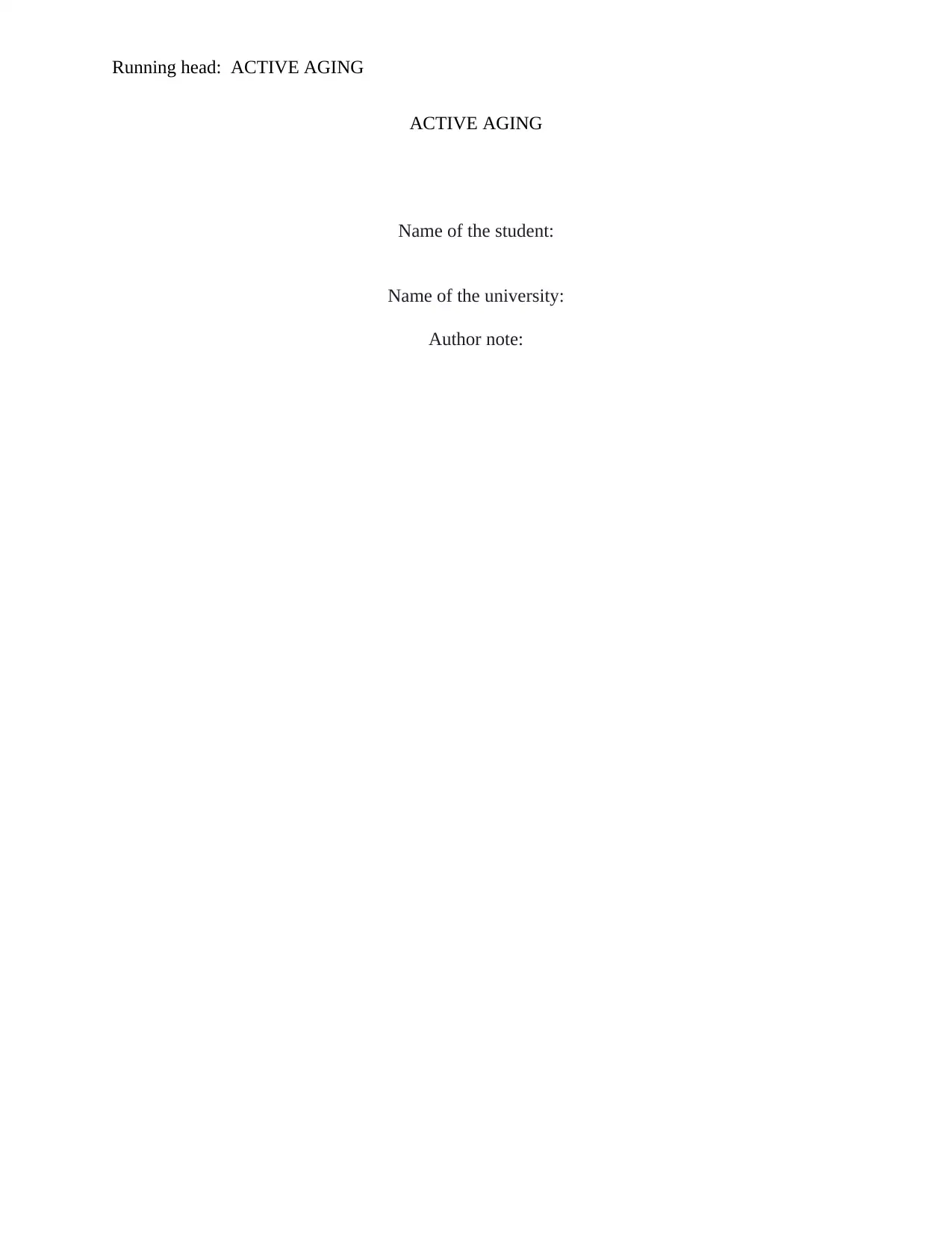
Running head: ACTIVE AGING
ACTIVE AGING
Name of the student:
Name of the university:
Author note:
ACTIVE AGING
Name of the student:
Name of the university:
Author note:
Secure Best Marks with AI Grader
Need help grading? Try our AI Grader for instant feedback on your assignments.
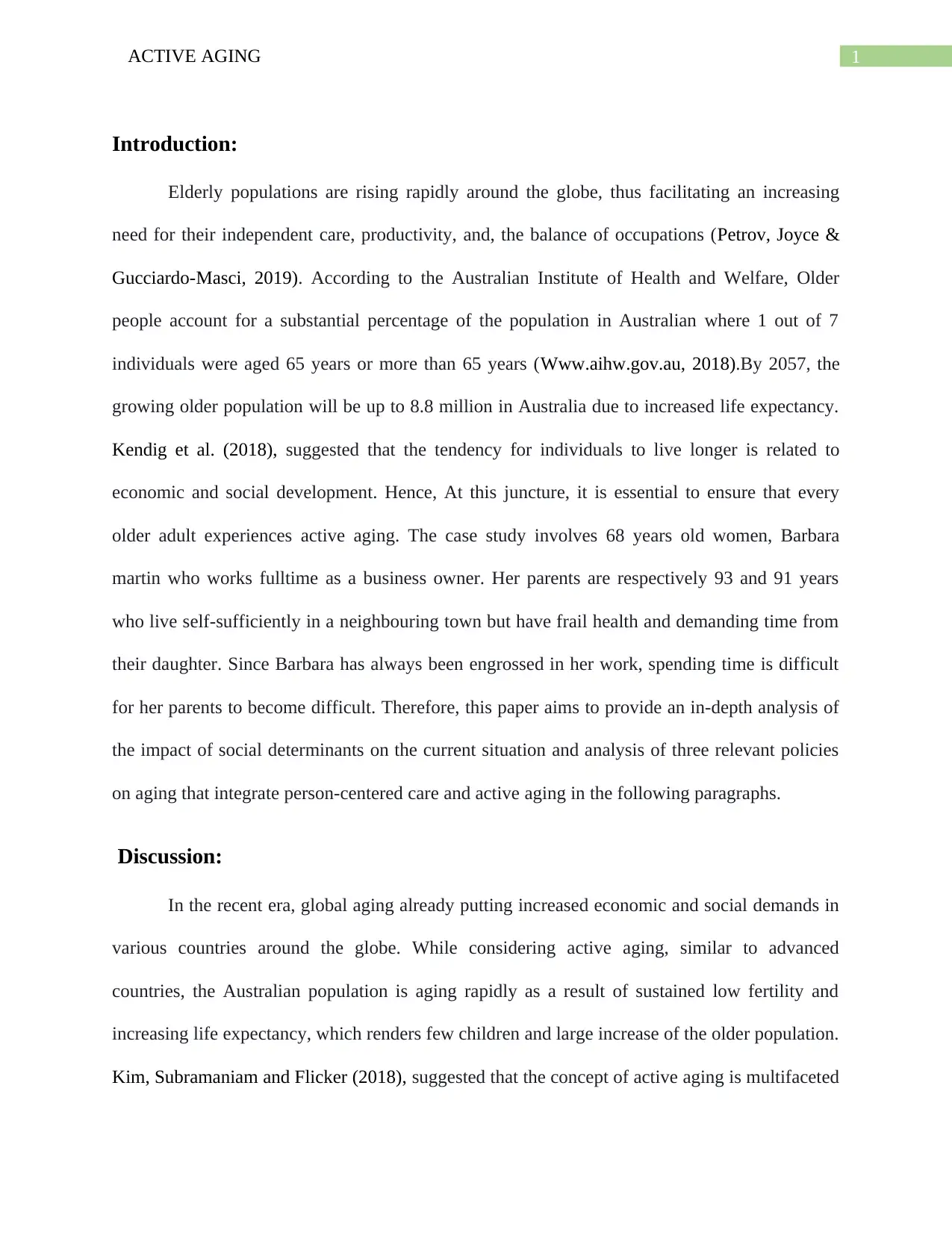
1ACTIVE AGING
Introduction:
Elderly populations are rising rapidly around the globe, thus facilitating an increasing
need for their independent care, productivity, and, the balance of occupations (Petrov, Joyce &
Gucciardo-Masci, 2019). According to the Australian Institute of Health and Welfare, Older
people account for a substantial percentage of the population in Australian where 1 out of 7
individuals were aged 65 years or more than 65 years (Www.aihw.gov.au, 2018).By 2057, the
growing older population will be up to 8.8 million in Australia due to increased life expectancy.
Kendig et al. (2018), suggested that the tendency for individuals to live longer is related to
economic and social development. Hence, At this juncture, it is essential to ensure that every
older adult experiences active aging. The case study involves 68 years old women, Barbara
martin who works fulltime as a business owner. Her parents are respectively 93 and 91 years
who live self-sufficiently in a neighbouring town but have frail health and demanding time from
their daughter. Since Barbara has always been engrossed in her work, spending time is difficult
for her parents to become difficult. Therefore, this paper aims to provide an in-depth analysis of
the impact of social determinants on the current situation and analysis of three relevant policies
on aging that integrate person-centered care and active aging in the following paragraphs.
Discussion:
In the recent era, global aging already putting increased economic and social demands in
various countries around the globe. While considering active aging, similar to advanced
countries, the Australian population is aging rapidly as a result of sustained low fertility and
increasing life expectancy, which renders few children and large increase of the older population.
Kim, Subramaniam and Flicker (2018), suggested that the concept of active aging is multifaceted
Introduction:
Elderly populations are rising rapidly around the globe, thus facilitating an increasing
need for their independent care, productivity, and, the balance of occupations (Petrov, Joyce &
Gucciardo-Masci, 2019). According to the Australian Institute of Health and Welfare, Older
people account for a substantial percentage of the population in Australian where 1 out of 7
individuals were aged 65 years or more than 65 years (Www.aihw.gov.au, 2018).By 2057, the
growing older population will be up to 8.8 million in Australia due to increased life expectancy.
Kendig et al. (2018), suggested that the tendency for individuals to live longer is related to
economic and social development. Hence, At this juncture, it is essential to ensure that every
older adult experiences active aging. The case study involves 68 years old women, Barbara
martin who works fulltime as a business owner. Her parents are respectively 93 and 91 years
who live self-sufficiently in a neighbouring town but have frail health and demanding time from
their daughter. Since Barbara has always been engrossed in her work, spending time is difficult
for her parents to become difficult. Therefore, this paper aims to provide an in-depth analysis of
the impact of social determinants on the current situation and analysis of three relevant policies
on aging that integrate person-centered care and active aging in the following paragraphs.
Discussion:
In the recent era, global aging already putting increased economic and social demands in
various countries around the globe. While considering active aging, similar to advanced
countries, the Australian population is aging rapidly as a result of sustained low fertility and
increasing life expectancy, which renders few children and large increase of the older population.
Kim, Subramaniam and Flicker (2018), suggested that the concept of active aging is multifaceted
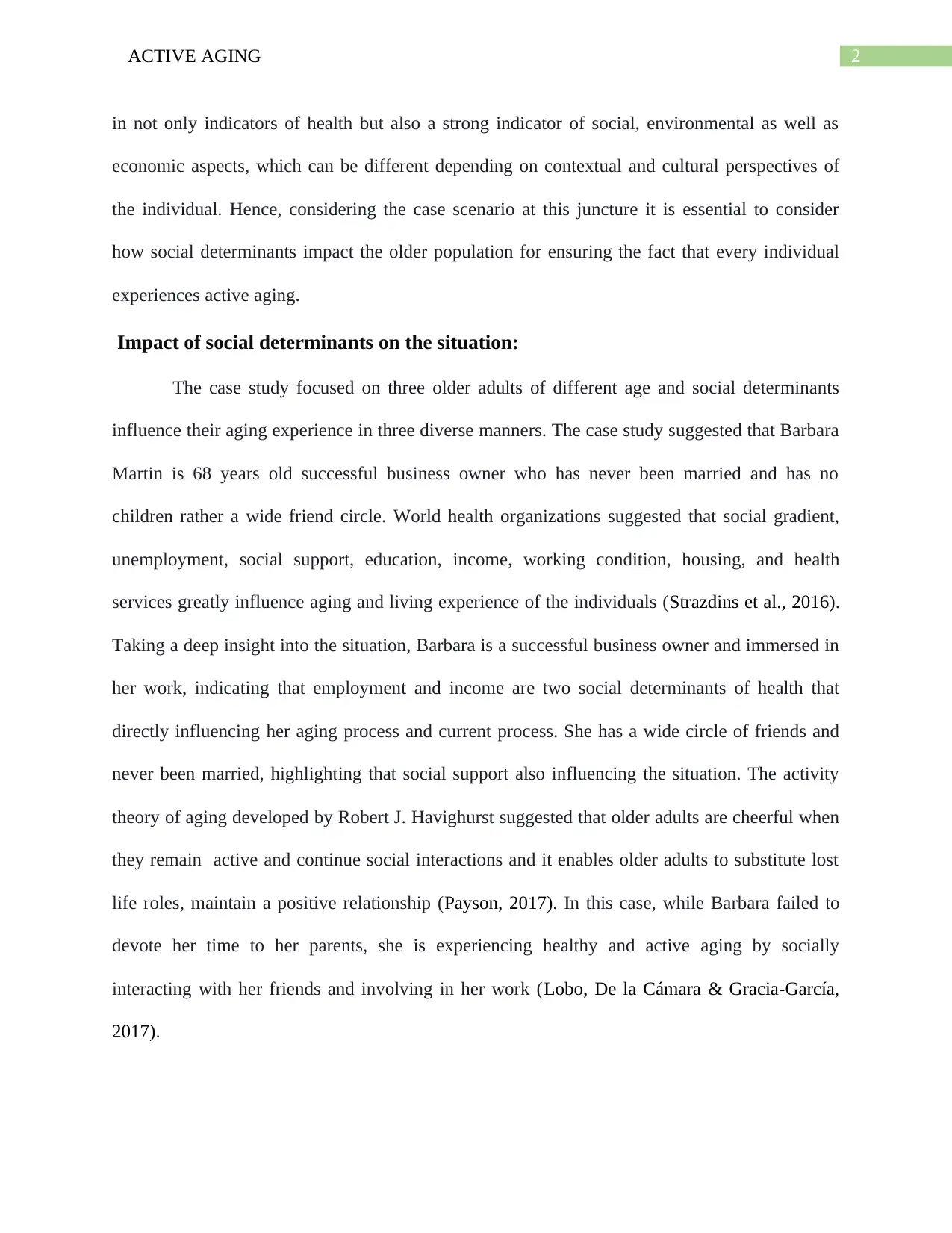
2ACTIVE AGING
in not only indicators of health but also a strong indicator of social, environmental as well as
economic aspects, which can be different depending on contextual and cultural perspectives of
the individual. Hence, considering the case scenario at this juncture it is essential to consider
how social determinants impact the older population for ensuring the fact that every individual
experiences active aging.
Impact of social determinants on the situation:
The case study focused on three older adults of different age and social determinants
influence their aging experience in three diverse manners. The case study suggested that Barbara
Martin is 68 years old successful business owner who has never been married and has no
children rather a wide friend circle. World health organizations suggested that social gradient,
unemployment, social support, education, income, working condition, housing, and health
services greatly influence aging and living experience of the individuals (Strazdins et al., 2016).
Taking a deep insight into the situation, Barbara is a successful business owner and immersed in
her work, indicating that employment and income are two social determinants of health that
directly influencing her aging process and current process. She has a wide circle of friends and
never been married, highlighting that social support also influencing the situation. The activity
theory of aging developed by Robert J. Havighurst suggested that older adults are cheerful when
they remain active and continue social interactions and it enables older adults to substitute lost
life roles, maintain a positive relationship (Payson, 2017). In this case, while Barbara failed to
devote her time to her parents, she is experiencing healthy and active aging by socially
interacting with her friends and involving in her work (Lobo, De la Cámara & Gracia-García,
2017).
in not only indicators of health but also a strong indicator of social, environmental as well as
economic aspects, which can be different depending on contextual and cultural perspectives of
the individual. Hence, considering the case scenario at this juncture it is essential to consider
how social determinants impact the older population for ensuring the fact that every individual
experiences active aging.
Impact of social determinants on the situation:
The case study focused on three older adults of different age and social determinants
influence their aging experience in three diverse manners. The case study suggested that Barbara
Martin is 68 years old successful business owner who has never been married and has no
children rather a wide friend circle. World health organizations suggested that social gradient,
unemployment, social support, education, income, working condition, housing, and health
services greatly influence aging and living experience of the individuals (Strazdins et al., 2016).
Taking a deep insight into the situation, Barbara is a successful business owner and immersed in
her work, indicating that employment and income are two social determinants of health that
directly influencing her aging process and current process. She has a wide circle of friends and
never been married, highlighting that social support also influencing the situation. The activity
theory of aging developed by Robert J. Havighurst suggested that older adults are cheerful when
they remain active and continue social interactions and it enables older adults to substitute lost
life roles, maintain a positive relationship (Payson, 2017). In this case, while Barbara failed to
devote her time to her parents, she is experiencing healthy and active aging by socially
interacting with her friends and involving in her work (Lobo, De la Cámara & Gracia-García,
2017).
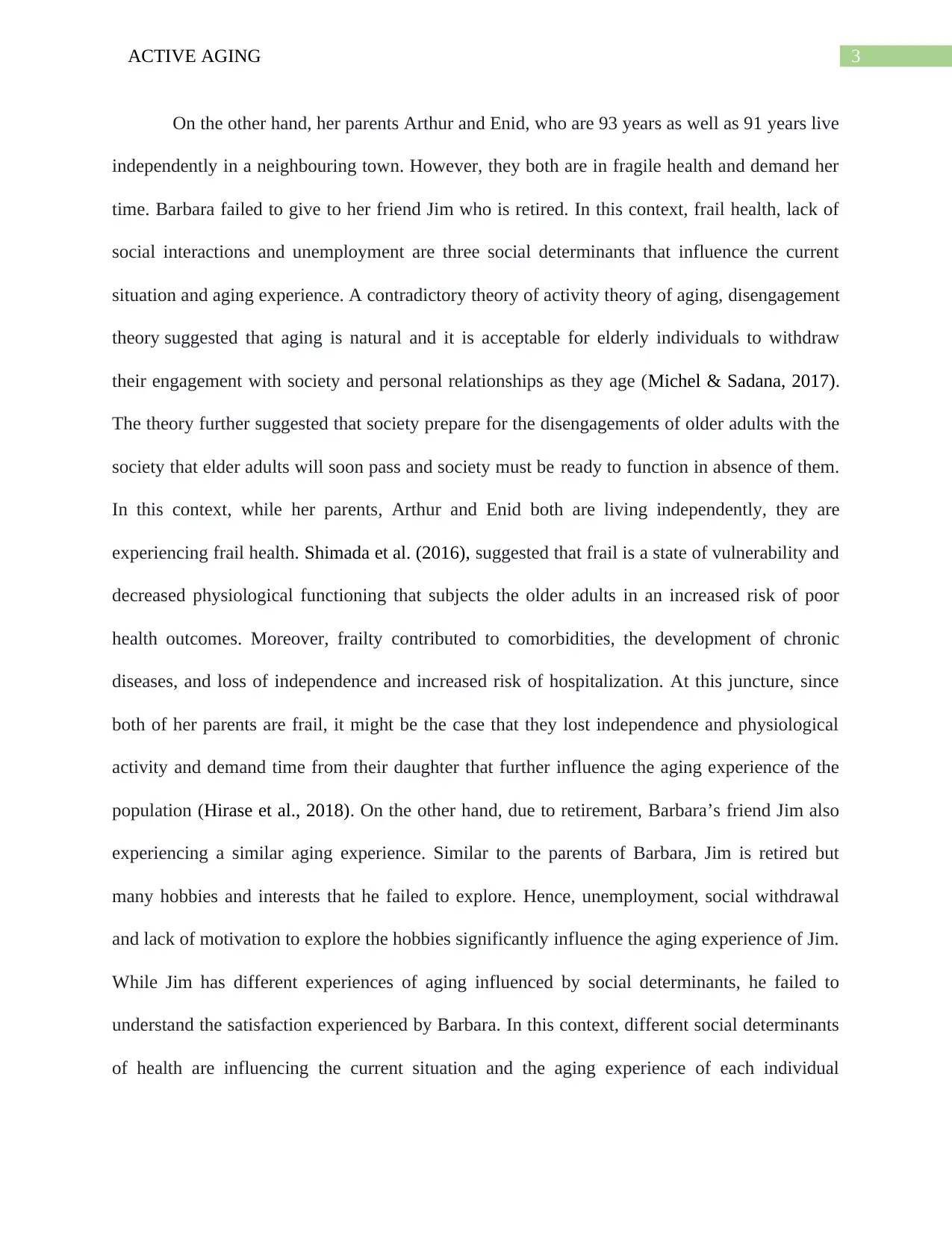
3ACTIVE AGING
On the other hand, her parents Arthur and Enid, who are 93 years as well as 91 years live
independently in a neighbouring town. However, they both are in fragile health and demand her
time. Barbara failed to give to her friend Jim who is retired. In this context, frail health, lack of
social interactions and unemployment are three social determinants that influence the current
situation and aging experience. A contradictory theory of activity theory of aging, disengagement
theory suggested that aging is natural and it is acceptable for elderly individuals to withdraw
their engagement with society and personal relationships as they age (Michel & Sadana, 2017).
The theory further suggested that society prepare for the disengagements of older adults with the
society that elder adults will soon pass and society must be ready to function in absence of them.
In this context, while her parents, Arthur and Enid both are living independently, they are
experiencing frail health. Shimada et al. (2016), suggested that frail is a state of vulnerability and
decreased physiological functioning that subjects the older adults in an increased risk of poor
health outcomes. Moreover, frailty contributed to comorbidities, the development of chronic
diseases, and loss of independence and increased risk of hospitalization. At this juncture, since
both of her parents are frail, it might be the case that they lost independence and physiological
activity and demand time from their daughter that further influence the aging experience of the
population (Hirase et al., 2018). On the other hand, due to retirement, Barbara’s friend Jim also
experiencing a similar aging experience. Similar to the parents of Barbara, Jim is retired but
many hobbies and interests that he failed to explore. Hence, unemployment, social withdrawal
and lack of motivation to explore the hobbies significantly influence the aging experience of Jim.
While Jim has different experiences of aging influenced by social determinants, he failed to
understand the satisfaction experienced by Barbara. In this context, different social determinants
of health are influencing the current situation and the aging experience of each individual
On the other hand, her parents Arthur and Enid, who are 93 years as well as 91 years live
independently in a neighbouring town. However, they both are in fragile health and demand her
time. Barbara failed to give to her friend Jim who is retired. In this context, frail health, lack of
social interactions and unemployment are three social determinants that influence the current
situation and aging experience. A contradictory theory of activity theory of aging, disengagement
theory suggested that aging is natural and it is acceptable for elderly individuals to withdraw
their engagement with society and personal relationships as they age (Michel & Sadana, 2017).
The theory further suggested that society prepare for the disengagements of older adults with the
society that elder adults will soon pass and society must be ready to function in absence of them.
In this context, while her parents, Arthur and Enid both are living independently, they are
experiencing frail health. Shimada et al. (2016), suggested that frail is a state of vulnerability and
decreased physiological functioning that subjects the older adults in an increased risk of poor
health outcomes. Moreover, frailty contributed to comorbidities, the development of chronic
diseases, and loss of independence and increased risk of hospitalization. At this juncture, since
both of her parents are frail, it might be the case that they lost independence and physiological
activity and demand time from their daughter that further influence the aging experience of the
population (Hirase et al., 2018). On the other hand, due to retirement, Barbara’s friend Jim also
experiencing a similar aging experience. Similar to the parents of Barbara, Jim is retired but
many hobbies and interests that he failed to explore. Hence, unemployment, social withdrawal
and lack of motivation to explore the hobbies significantly influence the aging experience of Jim.
While Jim has different experiences of aging influenced by social determinants, he failed to
understand the satisfaction experienced by Barbara. In this context, different social determinants
of health are influencing the current situation and the aging experience of each individual
Secure Best Marks with AI Grader
Need help grading? Try our AI Grader for instant feedback on your assignments.
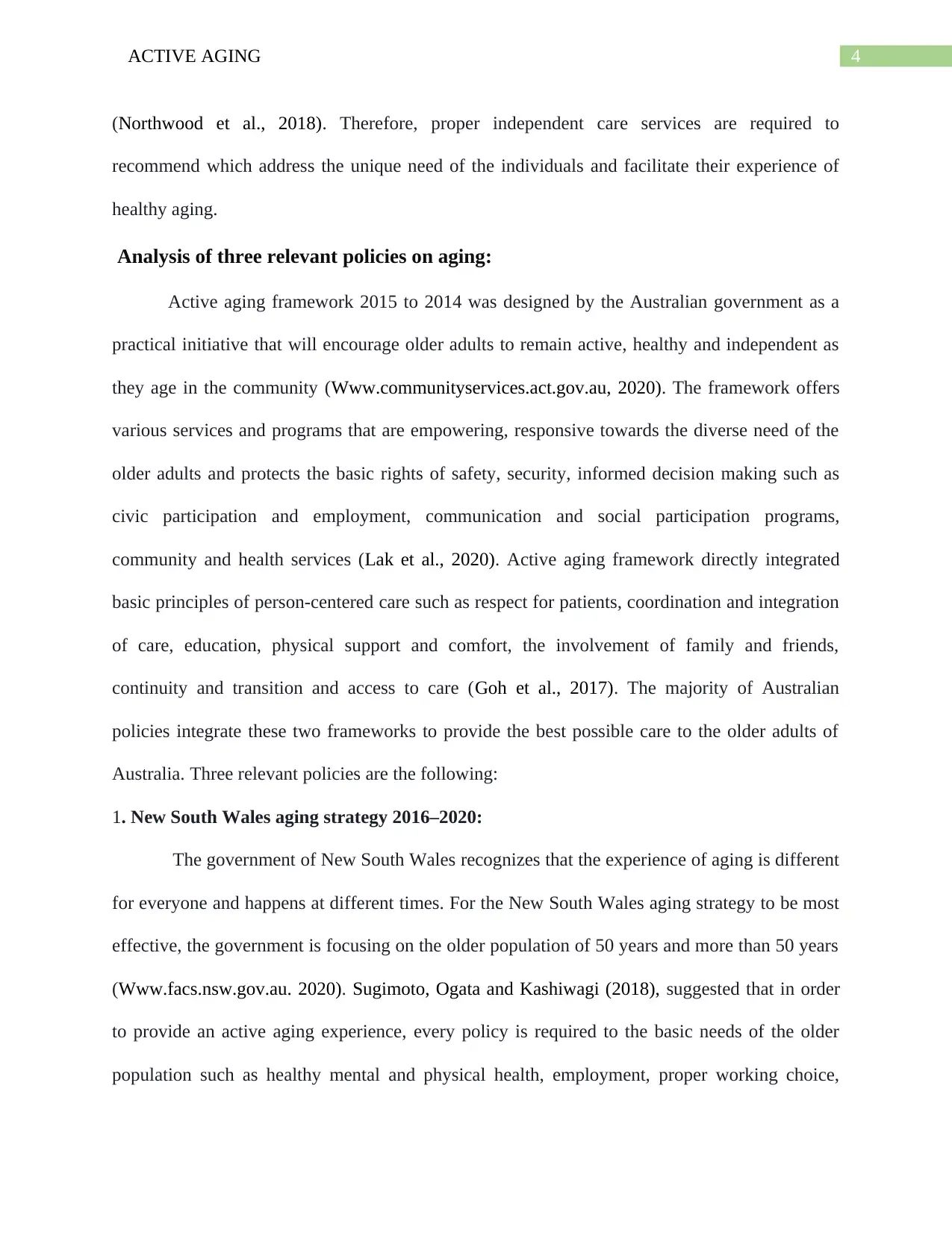
4ACTIVE AGING
(Northwood et al., 2018). Therefore, proper independent care services are required to
recommend which address the unique need of the individuals and facilitate their experience of
healthy aging.
Analysis of three relevant policies on aging:
Active aging framework 2015 to 2014 was designed by the Australian government as a
practical initiative that will encourage older adults to remain active, healthy and independent as
they age in the community (Www.communityservices.act.gov.au, 2020). The framework offers
various services and programs that are empowering, responsive towards the diverse need of the
older adults and protects the basic rights of safety, security, informed decision making such as
civic participation and employment, communication and social participation programs,
community and health services (Lak et al., 2020). Active aging framework directly integrated
basic principles of person-centered care such as respect for patients, coordination and integration
of care, education, physical support and comfort, the involvement of family and friends,
continuity and transition and access to care (Goh et al., 2017). The majority of Australian
policies integrate these two frameworks to provide the best possible care to the older adults of
Australia. Three relevant policies are the following:
1. New South Wales aging strategy 2016–2020:
The government of New South Wales recognizes that the experience of aging is different
for everyone and happens at different times. For the New South Wales aging strategy to be most
effective, the government is focusing on the older population of 50 years and more than 50 years
(Www.facs.nsw.gov.au. 2020). Sugimoto, Ogata and Kashiwagi (2018), suggested that in order
to provide an active aging experience, every policy is required to the basic needs of the older
population such as healthy mental and physical health, employment, proper working choice,
(Northwood et al., 2018). Therefore, proper independent care services are required to
recommend which address the unique need of the individuals and facilitate their experience of
healthy aging.
Analysis of three relevant policies on aging:
Active aging framework 2015 to 2014 was designed by the Australian government as a
practical initiative that will encourage older adults to remain active, healthy and independent as
they age in the community (Www.communityservices.act.gov.au, 2020). The framework offers
various services and programs that are empowering, responsive towards the diverse need of the
older adults and protects the basic rights of safety, security, informed decision making such as
civic participation and employment, communication and social participation programs,
community and health services (Lak et al., 2020). Active aging framework directly integrated
basic principles of person-centered care such as respect for patients, coordination and integration
of care, education, physical support and comfort, the involvement of family and friends,
continuity and transition and access to care (Goh et al., 2017). The majority of Australian
policies integrate these two frameworks to provide the best possible care to the older adults of
Australia. Three relevant policies are the following:
1. New South Wales aging strategy 2016–2020:
The government of New South Wales recognizes that the experience of aging is different
for everyone and happens at different times. For the New South Wales aging strategy to be most
effective, the government is focusing on the older population of 50 years and more than 50 years
(Www.facs.nsw.gov.au. 2020). Sugimoto, Ogata and Kashiwagi (2018), suggested that in order
to provide an active aging experience, every policy is required to the basic needs of the older
population such as healthy mental and physical health, employment, proper working choice,
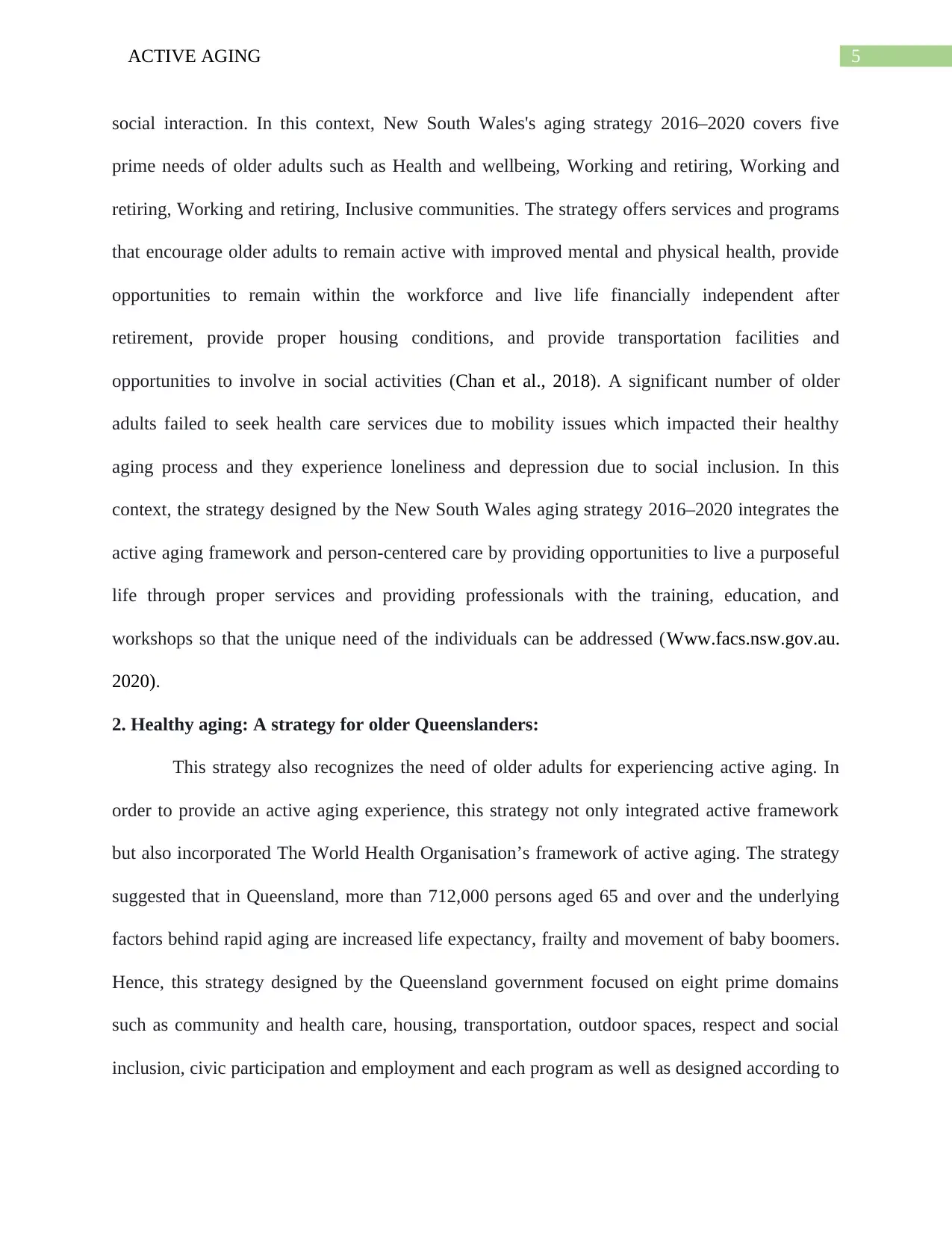
5ACTIVE AGING
social interaction. In this context, New South Wales's aging strategy 2016–2020 covers five
prime needs of older adults such as Health and wellbeing, Working and retiring, Working and
retiring, Working and retiring, Inclusive communities. The strategy offers services and programs
that encourage older adults to remain active with improved mental and physical health, provide
opportunities to remain within the workforce and live life financially independent after
retirement, provide proper housing conditions, and provide transportation facilities and
opportunities to involve in social activities (Chan et al., 2018). A significant number of older
adults failed to seek health care services due to mobility issues which impacted their healthy
aging process and they experience loneliness and depression due to social inclusion. In this
context, the strategy designed by the New South Wales aging strategy 2016–2020 integrates the
active aging framework and person-centered care by providing opportunities to live a purposeful
life through proper services and providing professionals with the training, education, and
workshops so that the unique need of the individuals can be addressed (Www.facs.nsw.gov.au.
2020).
2. Healthy aging: A strategy for older Queenslanders:
This strategy also recognizes the need of older adults for experiencing active aging. In
order to provide an active aging experience, this strategy not only integrated active framework
but also incorporated The World Health Organisation’s framework of active aging. The strategy
suggested that in Queensland, more than 712,000 persons aged 65 and over and the underlying
factors behind rapid aging are increased life expectancy, frailty and movement of baby boomers.
Hence, this strategy designed by the Queensland government focused on eight prime domains
such as community and health care, housing, transportation, outdoor spaces, respect and social
inclusion, civic participation and employment and each program as well as designed according to
social interaction. In this context, New South Wales's aging strategy 2016–2020 covers five
prime needs of older adults such as Health and wellbeing, Working and retiring, Working and
retiring, Working and retiring, Inclusive communities. The strategy offers services and programs
that encourage older adults to remain active with improved mental and physical health, provide
opportunities to remain within the workforce and live life financially independent after
retirement, provide proper housing conditions, and provide transportation facilities and
opportunities to involve in social activities (Chan et al., 2018). A significant number of older
adults failed to seek health care services due to mobility issues which impacted their healthy
aging process and they experience loneliness and depression due to social inclusion. In this
context, the strategy designed by the New South Wales aging strategy 2016–2020 integrates the
active aging framework and person-centered care by providing opportunities to live a purposeful
life through proper services and providing professionals with the training, education, and
workshops so that the unique need of the individuals can be addressed (Www.facs.nsw.gov.au.
2020).
2. Healthy aging: A strategy for older Queenslanders:
This strategy also recognizes the need of older adults for experiencing active aging. In
order to provide an active aging experience, this strategy not only integrated active framework
but also incorporated The World Health Organisation’s framework of active aging. The strategy
suggested that in Queensland, more than 712,000 persons aged 65 and over and the underlying
factors behind rapid aging are increased life expectancy, frailty and movement of baby boomers.
Hence, this strategy designed by the Queensland government focused on eight prime domains
such as community and health care, housing, transportation, outdoor spaces, respect and social
inclusion, civic participation and employment and each program as well as designed according to
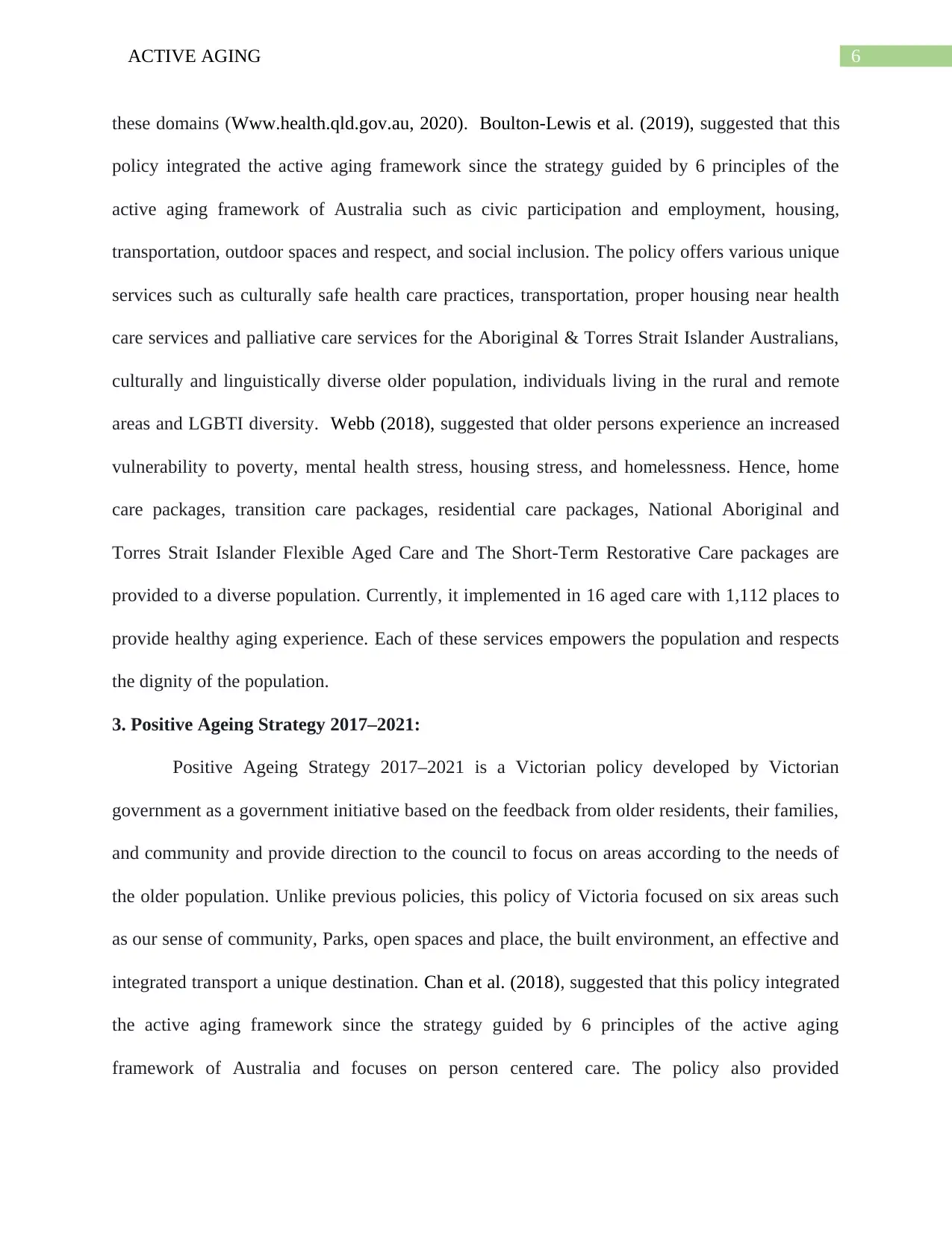
6ACTIVE AGING
these domains (Www.health.qld.gov.au, 2020). Boulton-Lewis et al. (2019), suggested that this
policy integrated the active aging framework since the strategy guided by 6 principles of the
active aging framework of Australia such as civic participation and employment, housing,
transportation, outdoor spaces and respect, and social inclusion. The policy offers various unique
services such as culturally safe health care practices, transportation, proper housing near health
care services and palliative care services for the Aboriginal & Torres Strait Islander Australians,
culturally and linguistically diverse older population, individuals living in the rural and remote
areas and LGBTI diversity. Webb (2018), suggested that older persons experience an increased
vulnerability to poverty, mental health stress, housing stress, and homelessness. Hence, home
care packages, transition care packages, residential care packages, National Aboriginal and
Torres Strait Islander Flexible Aged Care and The Short-Term Restorative Care packages are
provided to a diverse population. Currently, it implemented in 16 aged care with 1,112 places to
provide healthy aging experience. Each of these services empowers the population and respects
the dignity of the population.
3. Positive Ageing Strategy 2017–2021:
Positive Ageing Strategy 2017–2021 is a Victorian policy developed by Victorian
government as a government initiative based on the feedback from older residents, their families,
and community and provide direction to the council to focus on areas according to the needs of
the older population. Unlike previous policies, this policy of Victoria focused on six areas such
as our sense of community, Parks, open spaces and place, the built environment, an effective and
integrated transport a unique destination. Chan et al. (2018), suggested that this policy integrated
the active aging framework since the strategy guided by 6 principles of the active aging
framework of Australia and focuses on person centered care. The policy also provided
these domains (Www.health.qld.gov.au, 2020). Boulton-Lewis et al. (2019), suggested that this
policy integrated the active aging framework since the strategy guided by 6 principles of the
active aging framework of Australia such as civic participation and employment, housing,
transportation, outdoor spaces and respect, and social inclusion. The policy offers various unique
services such as culturally safe health care practices, transportation, proper housing near health
care services and palliative care services for the Aboriginal & Torres Strait Islander Australians,
culturally and linguistically diverse older population, individuals living in the rural and remote
areas and LGBTI diversity. Webb (2018), suggested that older persons experience an increased
vulnerability to poverty, mental health stress, housing stress, and homelessness. Hence, home
care packages, transition care packages, residential care packages, National Aboriginal and
Torres Strait Islander Flexible Aged Care and The Short-Term Restorative Care packages are
provided to a diverse population. Currently, it implemented in 16 aged care with 1,112 places to
provide healthy aging experience. Each of these services empowers the population and respects
the dignity of the population.
3. Positive Ageing Strategy 2017–2021:
Positive Ageing Strategy 2017–2021 is a Victorian policy developed by Victorian
government as a government initiative based on the feedback from older residents, their families,
and community and provide direction to the council to focus on areas according to the needs of
the older population. Unlike previous policies, this policy of Victoria focused on six areas such
as our sense of community, Parks, open spaces and place, the built environment, an effective and
integrated transport a unique destination. Chan et al. (2018), suggested that this policy integrated
the active aging framework since the strategy guided by 6 principles of the active aging
framework of Australia and focuses on person centered care. The policy also provided
Paraphrase This Document
Need a fresh take? Get an instant paraphrase of this document with our AI Paraphraser
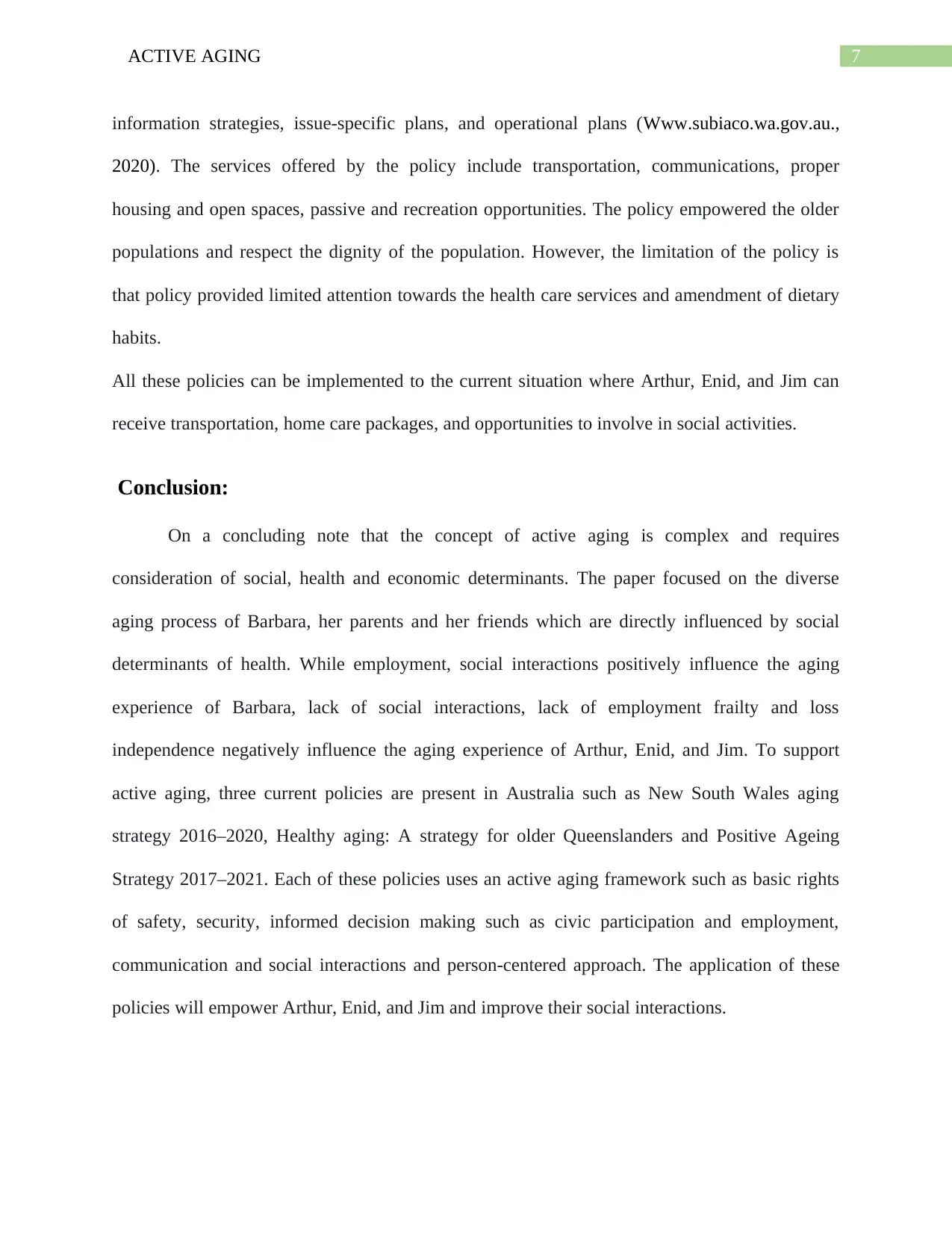
7ACTIVE AGING
information strategies, issue-specific plans, and operational plans (Www.subiaco.wa.gov.au.,
2020). The services offered by the policy include transportation, communications, proper
housing and open spaces, passive and recreation opportunities. The policy empowered the older
populations and respect the dignity of the population. However, the limitation of the policy is
that policy provided limited attention towards the health care services and amendment of dietary
habits.
All these policies can be implemented to the current situation where Arthur, Enid, and Jim can
receive transportation, home care packages, and opportunities to involve in social activities.
Conclusion:
On a concluding note that the concept of active aging is complex and requires
consideration of social, health and economic determinants. The paper focused on the diverse
aging process of Barbara, her parents and her friends which are directly influenced by social
determinants of health. While employment, social interactions positively influence the aging
experience of Barbara, lack of social interactions, lack of employment frailty and loss
independence negatively influence the aging experience of Arthur, Enid, and Jim. To support
active aging, three current policies are present in Australia such as New South Wales aging
strategy 2016–2020, Healthy aging: A strategy for older Queenslanders and Positive Ageing
Strategy 2017–2021. Each of these policies uses an active aging framework such as basic rights
of safety, security, informed decision making such as civic participation and employment,
communication and social interactions and person-centered approach. The application of these
policies will empower Arthur, Enid, and Jim and improve their social interactions.
information strategies, issue-specific plans, and operational plans (Www.subiaco.wa.gov.au.,
2020). The services offered by the policy include transportation, communications, proper
housing and open spaces, passive and recreation opportunities. The policy empowered the older
populations and respect the dignity of the population. However, the limitation of the policy is
that policy provided limited attention towards the health care services and amendment of dietary
habits.
All these policies can be implemented to the current situation where Arthur, Enid, and Jim can
receive transportation, home care packages, and opportunities to involve in social activities.
Conclusion:
On a concluding note that the concept of active aging is complex and requires
consideration of social, health and economic determinants. The paper focused on the diverse
aging process of Barbara, her parents and her friends which are directly influenced by social
determinants of health. While employment, social interactions positively influence the aging
experience of Barbara, lack of social interactions, lack of employment frailty and loss
independence negatively influence the aging experience of Arthur, Enid, and Jim. To support
active aging, three current policies are present in Australia such as New South Wales aging
strategy 2016–2020, Healthy aging: A strategy for older Queenslanders and Positive Ageing
Strategy 2017–2021. Each of these policies uses an active aging framework such as basic rights
of safety, security, informed decision making such as civic participation and employment,
communication and social interactions and person-centered approach. The application of these
policies will empower Arthur, Enid, and Jim and improve their social interactions.
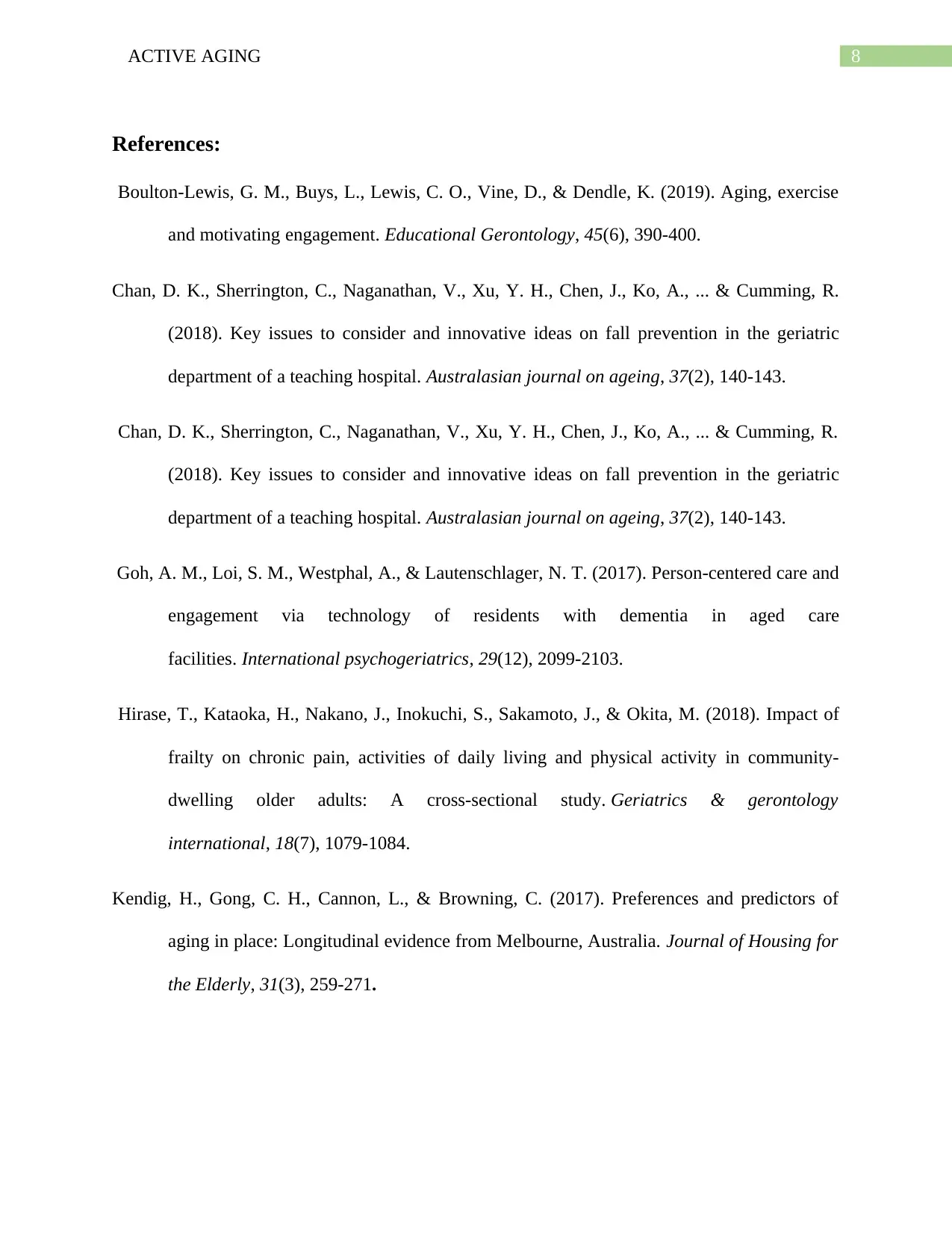
8ACTIVE AGING
References:
Boulton-Lewis, G. M., Buys, L., Lewis, C. O., Vine, D., & Dendle, K. (2019). Aging, exercise
and motivating engagement. Educational Gerontology, 45(6), 390-400.
Chan, D. K., Sherrington, C., Naganathan, V., Xu, Y. H., Chen, J., Ko, A., ... & Cumming, R.
(2018). Key issues to consider and innovative ideas on fall prevention in the geriatric
department of a teaching hospital. Australasian journal on ageing, 37(2), 140-143.
Chan, D. K., Sherrington, C., Naganathan, V., Xu, Y. H., Chen, J., Ko, A., ... & Cumming, R.
(2018). Key issues to consider and innovative ideas on fall prevention in the geriatric
department of a teaching hospital. Australasian journal on ageing, 37(2), 140-143.
Goh, A. M., Loi, S. M., Westphal, A., & Lautenschlager, N. T. (2017). Person-centered care and
engagement via technology of residents with dementia in aged care
facilities. International psychogeriatrics, 29(12), 2099-2103.
Hirase, T., Kataoka, H., Nakano, J., Inokuchi, S., Sakamoto, J., & Okita, M. (2018). Impact of
frailty on chronic pain, activities of daily living and physical activity in community‐
dwelling older adults: A cross‐sectional study. Geriatrics & gerontology
international, 18(7), 1079-1084.
Kendig, H., Gong, C. H., Cannon, L., & Browning, C. (2017). Preferences and predictors of
aging in place: Longitudinal evidence from Melbourne, Australia. Journal of Housing for
the Elderly, 31(3), 259-271.
References:
Boulton-Lewis, G. M., Buys, L., Lewis, C. O., Vine, D., & Dendle, K. (2019). Aging, exercise
and motivating engagement. Educational Gerontology, 45(6), 390-400.
Chan, D. K., Sherrington, C., Naganathan, V., Xu, Y. H., Chen, J., Ko, A., ... & Cumming, R.
(2018). Key issues to consider and innovative ideas on fall prevention in the geriatric
department of a teaching hospital. Australasian journal on ageing, 37(2), 140-143.
Chan, D. K., Sherrington, C., Naganathan, V., Xu, Y. H., Chen, J., Ko, A., ... & Cumming, R.
(2018). Key issues to consider and innovative ideas on fall prevention in the geriatric
department of a teaching hospital. Australasian journal on ageing, 37(2), 140-143.
Goh, A. M., Loi, S. M., Westphal, A., & Lautenschlager, N. T. (2017). Person-centered care and
engagement via technology of residents with dementia in aged care
facilities. International psychogeriatrics, 29(12), 2099-2103.
Hirase, T., Kataoka, H., Nakano, J., Inokuchi, S., Sakamoto, J., & Okita, M. (2018). Impact of
frailty on chronic pain, activities of daily living and physical activity in community‐
dwelling older adults: A cross‐sectional study. Geriatrics & gerontology
international, 18(7), 1079-1084.
Kendig, H., Gong, C. H., Cannon, L., & Browning, C. (2017). Preferences and predictors of
aging in place: Longitudinal evidence from Melbourne, Australia. Journal of Housing for
the Elderly, 31(3), 259-271.
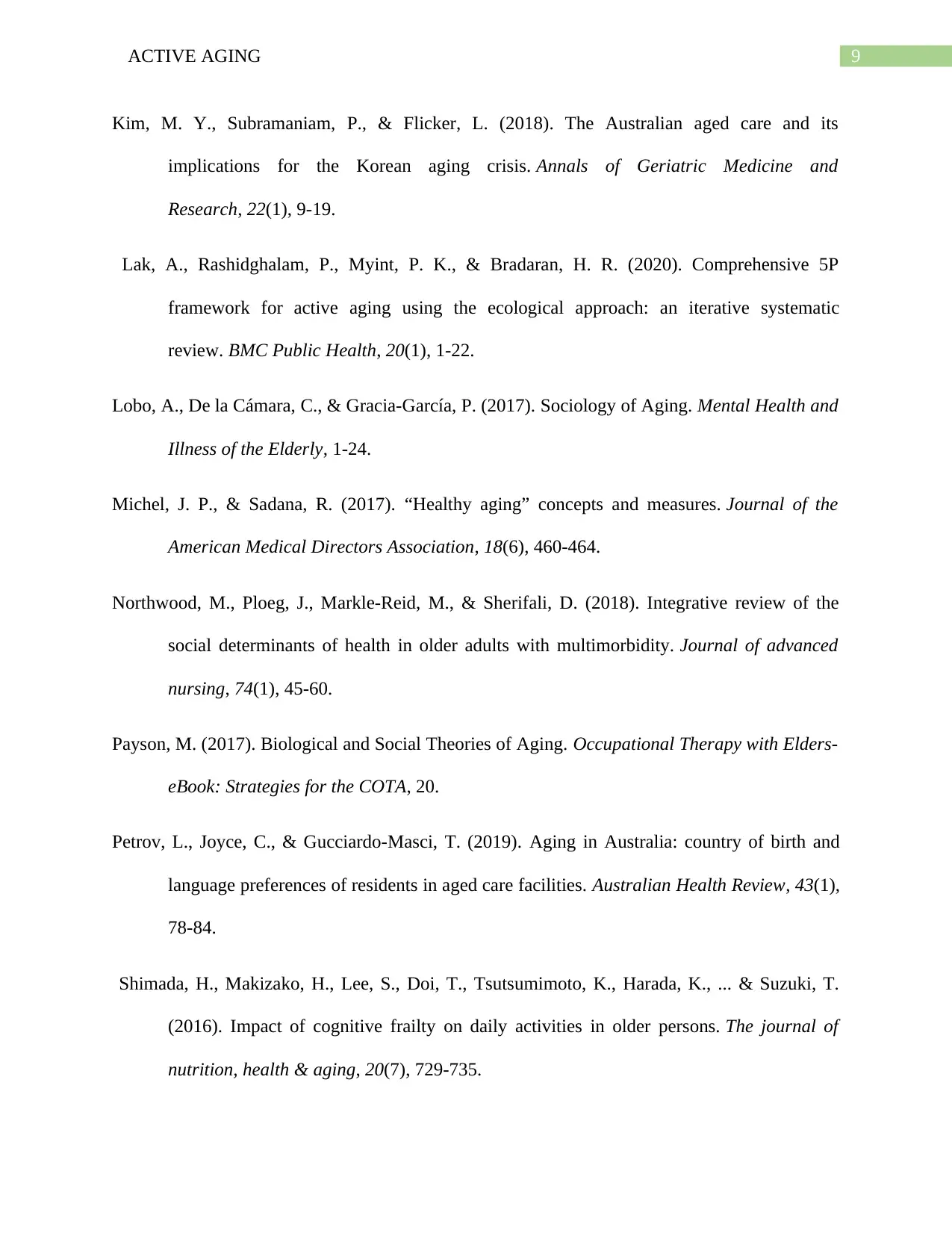
9ACTIVE AGING
Kim, M. Y., Subramaniam, P., & Flicker, L. (2018). The Australian aged care and its
implications for the Korean aging crisis. Annals of Geriatric Medicine and
Research, 22(1), 9-19.
Lak, A., Rashidghalam, P., Myint, P. K., & Bradaran, H. R. (2020). Comprehensive 5P
framework for active aging using the ecological approach: an iterative systematic
review. BMC Public Health, 20(1), 1-22.
Lobo, A., De la Cámara, C., & Gracia-García, P. (2017). Sociology of Aging. Mental Health and
Illness of the Elderly, 1-24.
Michel, J. P., & Sadana, R. (2017). “Healthy aging” concepts and measures. Journal of the
American Medical Directors Association, 18(6), 460-464.
Northwood, M., Ploeg, J., Markle‐Reid, M., & Sherifali, D. (2018). Integrative review of the
social determinants of health in older adults with multimorbidity. Journal of advanced
nursing, 74(1), 45-60.
Payson, M. (2017). Biological and Social Theories of Aging. Occupational Therapy with Elders-
eBook: Strategies for the COTA, 20.
Petrov, L., Joyce, C., & Gucciardo-Masci, T. (2019). Aging in Australia: country of birth and
language preferences of residents in aged care facilities. Australian Health Review, 43(1),
78-84.
Shimada, H., Makizako, H., Lee, S., Doi, T., Tsutsumimoto, K., Harada, K., ... & Suzuki, T.
(2016). Impact of cognitive frailty on daily activities in older persons. The journal of
nutrition, health & aging, 20(7), 729-735.
Kim, M. Y., Subramaniam, P., & Flicker, L. (2018). The Australian aged care and its
implications for the Korean aging crisis. Annals of Geriatric Medicine and
Research, 22(1), 9-19.
Lak, A., Rashidghalam, P., Myint, P. K., & Bradaran, H. R. (2020). Comprehensive 5P
framework for active aging using the ecological approach: an iterative systematic
review. BMC Public Health, 20(1), 1-22.
Lobo, A., De la Cámara, C., & Gracia-García, P. (2017). Sociology of Aging. Mental Health and
Illness of the Elderly, 1-24.
Michel, J. P., & Sadana, R. (2017). “Healthy aging” concepts and measures. Journal of the
American Medical Directors Association, 18(6), 460-464.
Northwood, M., Ploeg, J., Markle‐Reid, M., & Sherifali, D. (2018). Integrative review of the
social determinants of health in older adults with multimorbidity. Journal of advanced
nursing, 74(1), 45-60.
Payson, M. (2017). Biological and Social Theories of Aging. Occupational Therapy with Elders-
eBook: Strategies for the COTA, 20.
Petrov, L., Joyce, C., & Gucciardo-Masci, T. (2019). Aging in Australia: country of birth and
language preferences of residents in aged care facilities. Australian Health Review, 43(1),
78-84.
Shimada, H., Makizako, H., Lee, S., Doi, T., Tsutsumimoto, K., Harada, K., ... & Suzuki, T.
(2016). Impact of cognitive frailty on daily activities in older persons. The journal of
nutrition, health & aging, 20(7), 729-735.
Secure Best Marks with AI Grader
Need help grading? Try our AI Grader for instant feedback on your assignments.
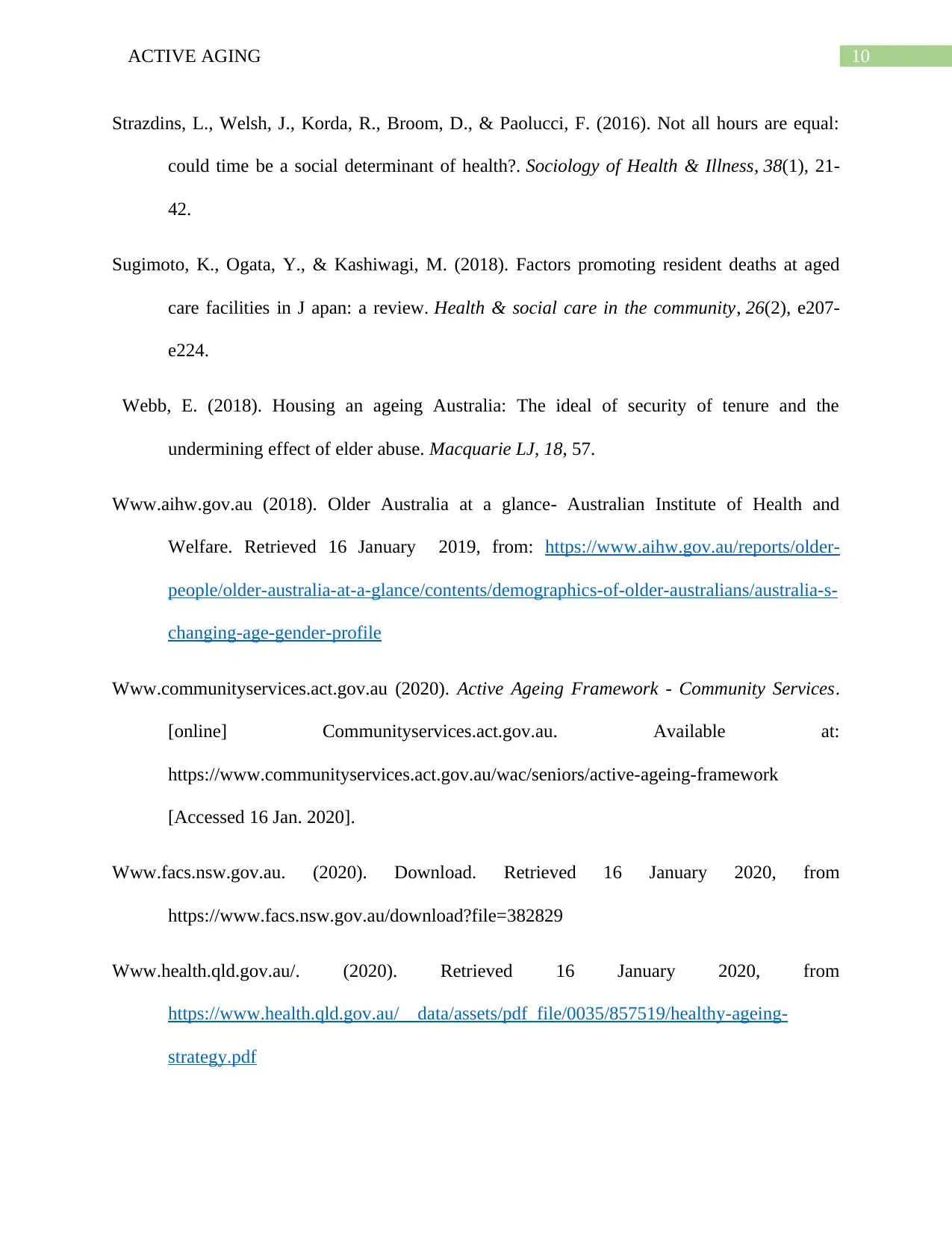
10ACTIVE AGING
Strazdins, L., Welsh, J., Korda, R., Broom, D., & Paolucci, F. (2016). Not all hours are equal:
could time be a social determinant of health?. Sociology of Health & Illness, 38(1), 21-
42.
Sugimoto, K., Ogata, Y., & Kashiwagi, M. (2018). Factors promoting resident deaths at aged
care facilities in J apan: a review. Health & social care in the community, 26(2), e207-
e224.
Webb, E. (2018). Housing an ageing Australia: The ideal of security of tenure and the
undermining effect of elder abuse. Macquarie LJ, 18, 57.
Www.aihw.gov.au (2018). Older Australia at a glance- Australian Institute of Health and
Welfare. Retrieved 16 January 2019, from: https://www.aihw.gov.au/reports/older-
people/older-australia-at-a-glance/contents/demographics-of-older-australians/australia-s-
changing-age-gender-profile
Www.communityservices.act.gov.au (2020). Active Ageing Framework - Community Services.
[online] Communityservices.act.gov.au. Available at:
https://www.communityservices.act.gov.au/wac/seniors/active-ageing-framework
[Accessed 16 Jan. 2020].
Www.facs.nsw.gov.au. (2020). Download. Retrieved 16 January 2020, from
https://www.facs.nsw.gov.au/download?file=382829
Www.health.qld.gov.au/. (2020). Retrieved 16 January 2020, from
https://www.health.qld.gov.au/__data/assets/pdf_file/0035/857519/healthy-ageing-
strategy.pdf
Strazdins, L., Welsh, J., Korda, R., Broom, D., & Paolucci, F. (2016). Not all hours are equal:
could time be a social determinant of health?. Sociology of Health & Illness, 38(1), 21-
42.
Sugimoto, K., Ogata, Y., & Kashiwagi, M. (2018). Factors promoting resident deaths at aged
care facilities in J apan: a review. Health & social care in the community, 26(2), e207-
e224.
Webb, E. (2018). Housing an ageing Australia: The ideal of security of tenure and the
undermining effect of elder abuse. Macquarie LJ, 18, 57.
Www.aihw.gov.au (2018). Older Australia at a glance- Australian Institute of Health and
Welfare. Retrieved 16 January 2019, from: https://www.aihw.gov.au/reports/older-
people/older-australia-at-a-glance/contents/demographics-of-older-australians/australia-s-
changing-age-gender-profile
Www.communityservices.act.gov.au (2020). Active Ageing Framework - Community Services.
[online] Communityservices.act.gov.au. Available at:
https://www.communityservices.act.gov.au/wac/seniors/active-ageing-framework
[Accessed 16 Jan. 2020].
Www.facs.nsw.gov.au. (2020). Download. Retrieved 16 January 2020, from
https://www.facs.nsw.gov.au/download?file=382829
Www.health.qld.gov.au/. (2020). Retrieved 16 January 2020, from
https://www.health.qld.gov.au/__data/assets/pdf_file/0035/857519/healthy-ageing-
strategy.pdf
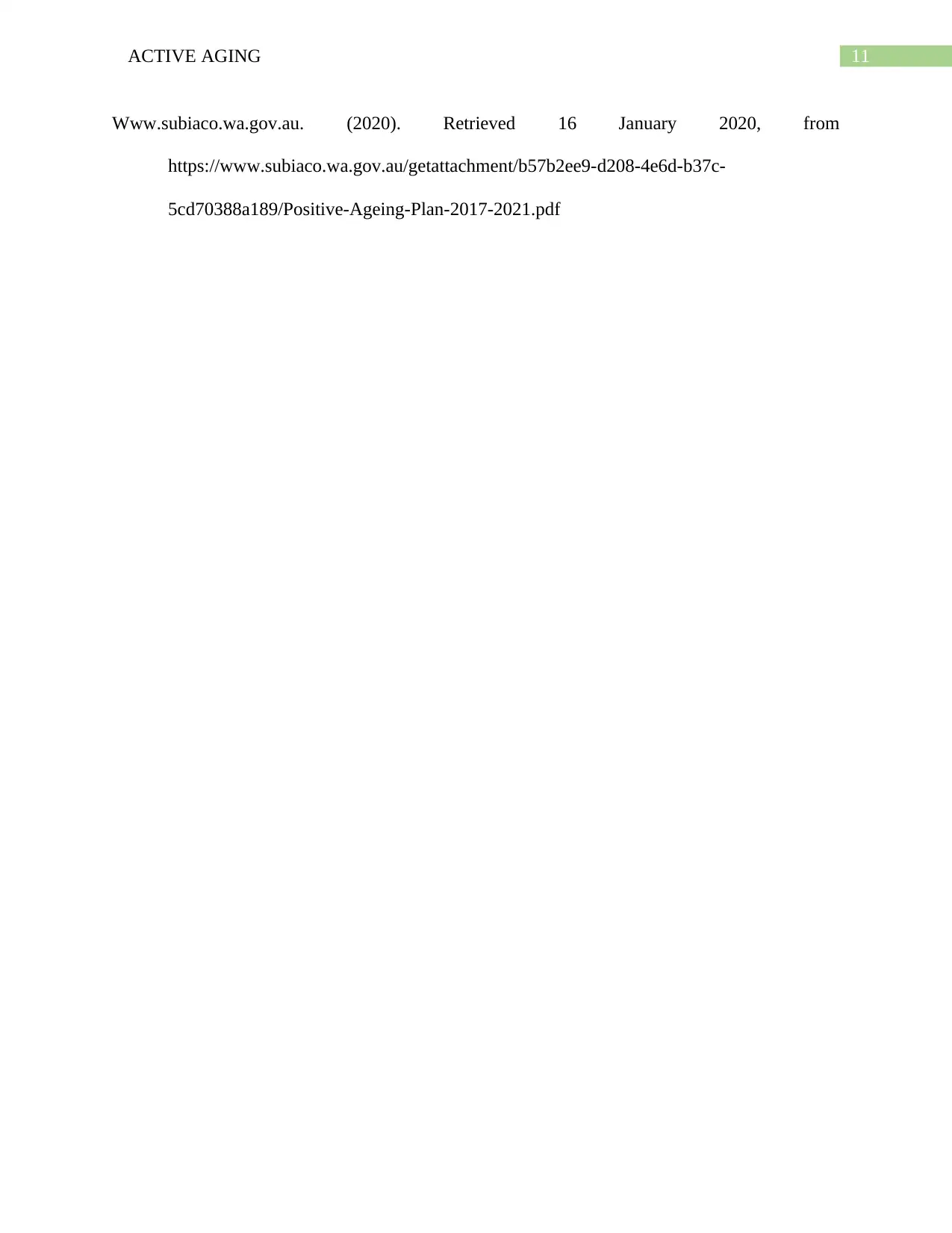
11ACTIVE AGING
Www.subiaco.wa.gov.au. (2020). Retrieved 16 January 2020, from
https://www.subiaco.wa.gov.au/getattachment/b57b2ee9-d208-4e6d-b37c-
5cd70388a189/Positive-Ageing-Plan-2017-2021.pdf
Www.subiaco.wa.gov.au. (2020). Retrieved 16 January 2020, from
https://www.subiaco.wa.gov.au/getattachment/b57b2ee9-d208-4e6d-b37c-
5cd70388a189/Positive-Ageing-Plan-2017-2021.pdf
1 out of 12
Related Documents
Your All-in-One AI-Powered Toolkit for Academic Success.
+13062052269
info@desklib.com
Available 24*7 on WhatsApp / Email
![[object Object]](/_next/static/media/star-bottom.7253800d.svg)
Unlock your academic potential
© 2024 | Zucol Services PVT LTD | All rights reserved.





